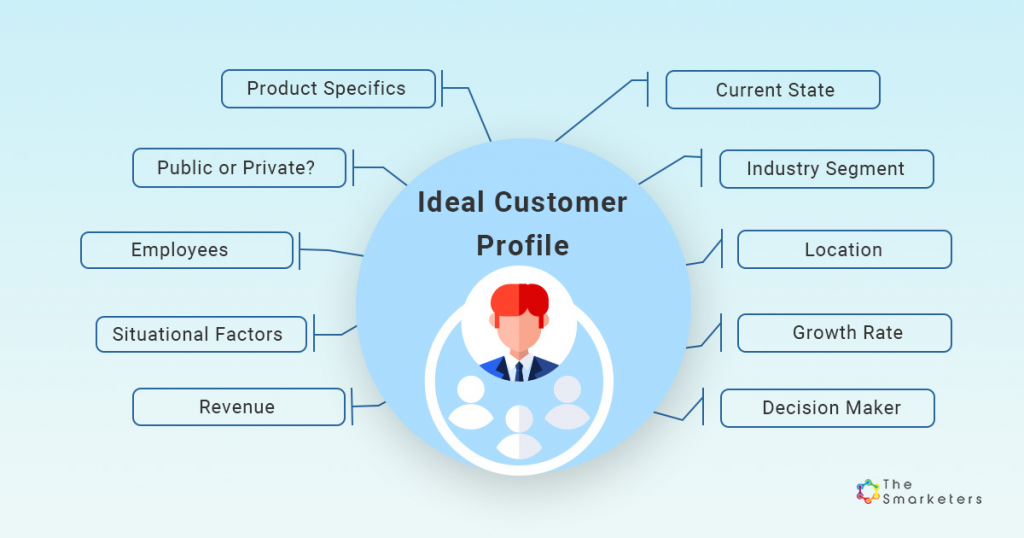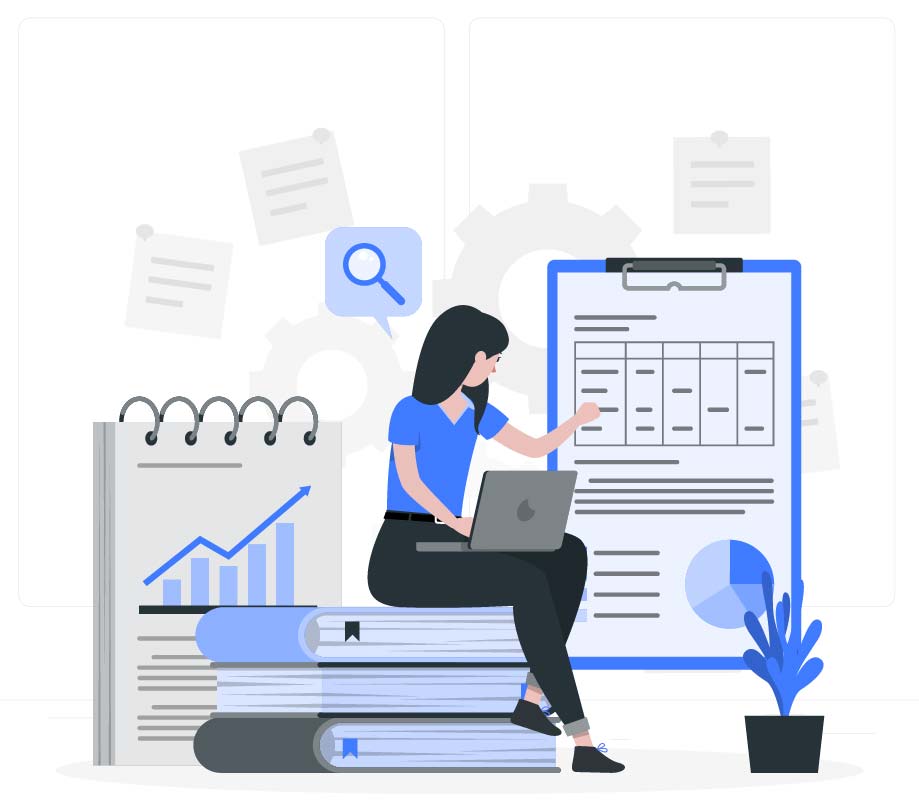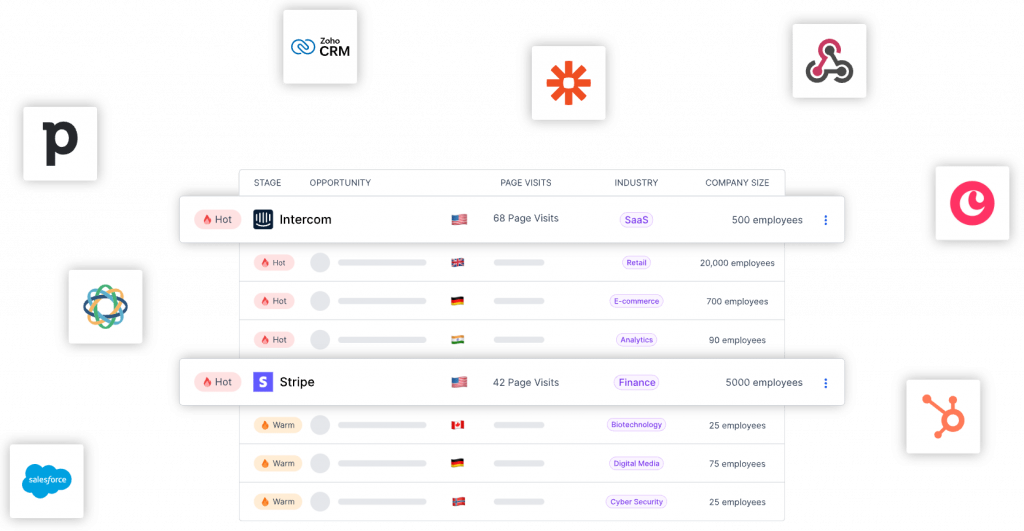ICPs in Marketing: How Can It Help You Acuire More Customers?
Imagine the ideal buyer for your product or service. For luxury fashion brands, it could be the elite class. However, in reality, it could also be middle-class individuals who aspire to feel affluent.
Certainly, brands like Gucci and Louis Vuitton understand who their customers truly are and craft their campaigns accordingly. This highlights the importance of comprehending ideal customers and underscores the misconception between ideal customer profiles (ICPs) and buyer personas.
Let’s dive deeper!
What is an Ideal Customer Profile (ICP)?

Image Source: The Smarketers
An Ideal Customer Profile (ICP) in marketing (slightly different from ICP in sales) is a detailed and strategic representation of the characteristics, attributes, and preferences that define the perfect customer for your business. This detailed description helps identify the kind of people who would not only love what you offer but also benefit the most from it.
Think of it as creating a character in a game – you’re outlining the traits, interests, and challenges that make someone a perfect fit for what you do.
With your ICP, you’re not just casting a wide net. Rather, you’re crafting a magnet that pulls in the individuals who will appreciate and connect with your products or services the most.
Key Components of ICPs in Marketing
Demographics: Basic information such as age, gender, location, and occupation can provide a foundational understanding of the customer base.
Firmographics (B2B): For businesses targeting other businesses, firmographics like industry, company size, and revenue become crucial factors.
Behavioral Characteristics: Understanding how customers interact with products, their purchasing behavior and their preferences is essential for tailoring marketing and sales strategies.
Challenges and Pain Points: Identifying the problems or challenges that customers face helps tailor products or services to address specific needs.
Goals and Aspirations: Knowing what customers are trying to achieve allows businesses to position their offerings as solutions that align with customer objectives.
Buying Motivations: Uncovering the reasons why customers choose a particular product or service helps refine marketing messages and highlight key selling points.
Communication Preferences: Understanding how customers prefer to be reached and engaged (e.g., email, social media, in-person) enhances the effectiveness of communication strategies.
Brand Affinities: Knowing which brands or products your ideal customers are already drawn to can inform partnership opportunities or complementary offerings.
How Does an ICP Correlate with a Buyer Persona?
ICPs in Marketing and Buyer Personas are related concepts. Each focuses on different aspects of the customer targeting process.
While they are distinct, it is safe to say that ICPs in marketing are the bigger picture and Buyer Personas are important elements that exist within those big pictures.

Image Source: Hubspot
To understand the correlation in a better way, let’s consider some important aspects.
Hierarchy
Think of defining the ICP as the overarching strategy that set the direction for the entire business. Buyer personas, then, are the tactical tools derived from the ICP to implement marketing strategies at a granular level.
Relationship
A business may have multiple buyer personas representing different segments of its ICP. Each persona is a manifestation of the broader ICPs in marketing. It embodies specific characteristics and behaviors within the overall target market.
Feedback Loop
As businesses gather more data and insights, the ICPs in marketing may evolve. Thus, influencing the creation or recalibration of buyer personas. Conversely, experiences and learnings from engaging with buyer personas can contribute to refining the ICP.
In essence, ICPs in marketing provide the strategic direction, defining the ideal market segment, while buyer personas bring that abstraction to life. Together, they create a comprehensive framework for customer targeting and engagement.
How to Correctly Define ICP for Your Business?

Defining ICPs in marketing for your business is an important strategic undertaking. It involves a combination of data analysis, market research, and a deep understanding of your current customer base.
Here’s a step-by-step guide to help you properly define your ICP.
1. Analyze Your Existing Customer Base
Gather data on your current customers, including demographics, firmographics (in B2B), behaviors, and purchase history. Look for commonalities and patterns among your most successful and satisfied customers. What traits do they share?
2. Conduct Market Research
If you’re in B2B, analyze the industries of your current clients. Identify industries that align with your business strengths and where there’s potential for growth. Understand who your competitors are targeting and identify gaps or opportunities within the market.
3. Define Key Characteristics
Clearly outline the demographic characteristics of your ideal customer, including age, gender, location, and income (for B2C). In B2B, consider factors like company size, industry, and location.
Identify behaviors that indicate a good fit for your product or service. This could include online behaviors, buying patterns, or engagement with specific content.
4. Identify Pain Points and Needs
Understand the pain points and challenges your customers face. How does your product or service address these issues? In what ways does your product provide value? Identify the needs and aspirations of your ideal customers. What are they looking to achieve, and how can your business help them reach those goals?
This information will help you accurately identify segments of your customers who will share specific pain points and needs that can be solved with your product.
5. Get Input from Sales and Customer Support Teams
Your sales and customer support teams interact directly with customers. Gather insights from them regarding common questions, objections, and customer feedback. Involving various teams in this process ensures a comprehensive understanding of your customers.
6. Refine and Iterate
Marketing ICPs are not static as your product, services or the market in general can evolve. Getting it right once won’t necessarily guarantee effectiveness over the long term. Regularly revisit and refine it based on new data, market shifts, and changes in your business strategy.
Stay agile and be open to adjusting your ICPs as needed!
7. Test and Validate
Implement the defining of ICPs in your marketing and sales efforts. Test its effectiveness in attracting and converting leads. Continuously measure and analyze results. If your ICP isn’t generating the desired outcomes, be prepared to refine it based on real-world feedback.
Remember, the key to a successful ICP is its accuracy and relevance to your business. It’s a dynamic tool that evolves with your business and market dynamics.
So let’s assume you perfected your ICP, what comes next? How does one start acquiring customers? Let’s glance over some effective strategies!
Strategies to Acquire Customers after Defining ICP
Once you’ve defined and perfected your ICP, implementing effective strategies to acquire customers becomes a targeted and strategic process. Here are five effective strategies to consider.
1. Precision Targeting
Customized Messaging: Tailor your marketing messages to resonate specifically with the characteristics and preferences outlined in your ICP.
Focused Campaigns: Launch targeted advertising campaigns on platforms where your ideal customers are most active. Use specific language and visuals that align with their needs and aspirations.
2. Inbound Marketing
Content Alignment: Develop content that directly addresses the pain points and challenges identified in your ICP. This could include blog posts, ebooks, webinars, or any content that provides value and attracts your ideal audience.
SEO Optimization: Optimize your website and content for search engines based on keywords and phrases your ideal customers are likely to use. This helps your content appear in their online searches.
3. Referral Programs
Leverage Existing Relationships: Encourage satisfied customers to refer others who fit the ICP. Offer incentives such as discounts, exclusive access, or rewards for successful referrals.
Strategic Partnerships: Collaborate with businesses that have a similar target audience. This can expand your reach and bring in customers who align with your ICP.
4. Personalized Sales Outreach
Segmented Email Campaigns: Use email marketing with personalized content based on different segments of your ICP. Consider the stage of the customer journey and tailor your messages accordingly.
Social Selling: Leverage social media platforms for personalized outreach. Engage with your ideal customers directly, share relevant content, and build relationships.
5. Customer Success Stories
Showcase Success: Highlight case studies and success stories that mirror the challenges and goals of your ICP. This provides real-world examples of how your product or service has benefited similar customers.
Testimonials and Reviews: Encourage satisfied customers to leave reviews and testimonials. Positive feedback from customers who align with your ICP can influence potential customers with similar profiles.
Remember, the key is to align all your acquisition strategies with your ICP.
Know When Accounts that Match Your ICP Visit Your Website
Now that you have defined your ICP, it would be great to know when customers who match your ICP are actually engaging with your business. While you will be aware when target customers sign up by filling out a form, having the knowledge that target accounts are engaging with your content immediately upon visiting your website provides an extra advantage.
This is where visitor deanonymization with a tool like Salespanel Account Reveal can help you achieve that edge. The tool aids in identifying key accounts, lead scoring, behavioral tracking, customer journey tracking, real-time alerts, and more.
Feel free to reach out to us if you want to learn more!

Conclusion
In conclusion, understanding Ideal Customer Profiles (ICPs) in marketing is crucial for effective customer targeting and engagement. It involves a strategic representation of characteristics, behaviors, and preferences defining the perfect customer. While ICPs provide the overarching strategy, Buyer Personas serve as tactical tools within this framework. Defining ICPs requires analyzing existing customer data, conducting market research, and refining characteristics, needs, and aspirations. Regular refinement, validation, and testing are essential for a dynamic and effective ICP. Once perfected, implementing precision targeting, inbound marketing, referral programs, personalized sales outreach, and showcasing success stories align with your ICP for successful customer acquisition.
Sell more, understand your customers’ journey for free!
Sales and Marketing teams spend millions of dollars to bring visitors to your website. But do you track your customer’s journey? Do you know who buys and why?
Around 8% of your website traffic will sign up on your lead forms. What happens to the other 92% of your traffic? Can you identify your visiting accounts? Can you engage and retarget your qualified visitors even if they are not identified?



